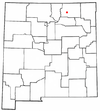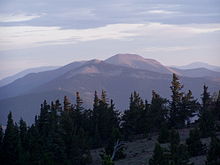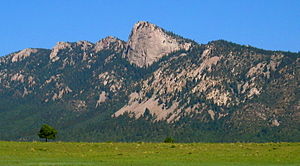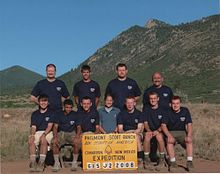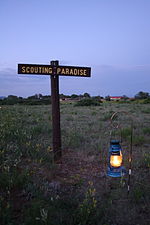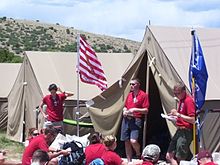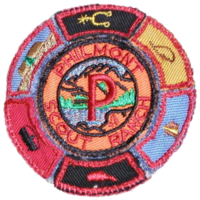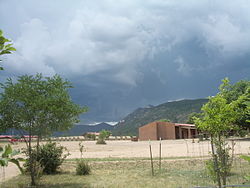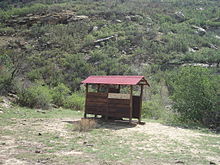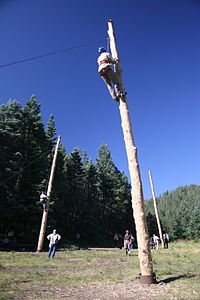- Philmont Scout Ranch
-
"Philmont" redirects here. For other uses, see Philmont (disambiguation).
Philmont Scout Ranch 
Black Bull, symbol of PhilmontOwner Boy Scouts of America Location Cimarron, New Mexico Country United States Coordinates 36°27′15″N 104°57′21″W / 36.45417°N 104.95583°W Founded 1938 Founder Waite Phillips Attendance 33,583 campers (2006)[1] Website
http://philmontscoutranch.org/Philmont Scout Ranch is a large, rugged, mountainous ranch located near the town of Cimarron, New Mexico, covering approximately 137,500 acres (556 km2) of wilderness in the Sangre de Cristo Mountains of the Rocky Mountains of northern New Mexico. The ranch, formerly the property of oil baron Waite Phillips and now that of the Boy Scouts of America, is currently in use as a National High Adventure Base in which crews of Scouts and Venturers take part in backpacking expeditions and other outdoor activities. It is the largest youth camp in the world by size and number of participants. Between June 8 and August 22 around 22,800 Scouts and adult leaders engage in backpacking treks around the Ranch's extensive backcountry while over 1,200 seasonal staff personnel maintain the Ranch's summer operations.
Philmont is also home to the Philmont Training Center, which is the main center for BSA's national-level training for volunteers and professionals. In addition to its extensive BSA programs, Philmont continues to operate as a ranch, maintaining a relatively small stock of cattle, horses, burros and bison.
It is the site of the only documented Tyrannosaurus rex track in the world (discovered in 1993 and formally identified in 1994) in North Ponil Canyon by Anasazi Trail Camp.[2]
Contents
Location and geography
Philmont is located in the Sangre de Cristo Mountains of the Rocky Mountains of New Mexico. The closest village is Cimarron, New Mexico, which sits at 36°27'13.04" North, 104°57'29.81" West (36.4536222, -104.9582806).[3] The address of the ranch is usually given as 17 Deer Run Rd., Cimarron, NM, 87714. It is also about 20 miles (30 km) west-northwest of Springer, New Mexico, and 35 miles (56 km) southwest of Raton, New Mexico. It is about 12 miles (19 km) across (east to west) at its widest point, and about 30 miles (48 km) long. There are no mountains to the south of Philmont, or to the east (indeed, part of the eastern fringe of the ranch is prairie) but the interior is quite mountainous.[4]
The lowest elevation is 6,500 feet (1981 m), at the southeast corner. The highest point is the peak of Baldy Mountain at 12,441 feet (3792 m), located on the ranch's northwest boundary. [5][4] The most recognizable landmark is the Tooth of Time at 9,003 feet (2744 m), a granite monolith protruding 500 feet (150 m) vertically from an east-west ridge. Tooth of Time Ridge, and the latitude line on which it sits, mark the boundary between the central and southern sections of Philmont. The boundary between the central and northern sections is around U.S. Route 64, which runs just south of the narrowest part of the 'I'-shape, which is only a few miles across.
Aside from Baldy, the ranch contains a number of prominent peaks. Directly south of Baldy lies Touch-Me-Not Mountain, which is located in Cimarron Canyon State Park. The South Country is home to a series of six difficult peaks, namely Mount Phillips, Comanche Peak, Big Red, Bear Mountain, Black Mountain, and Schaefers Peak. The final prominent South Country peak is Trail Peak, which is popular for its relative ease, its nearness to Beaubien, and the wreckage of the crash of a B-24 bomber in 1942 near its summit.
Of the ranch's various hikeable peaks (where a trail leads to the peak), Black Mountain is widely considered the most difficult, followed closely by Baldy and Big Red. Other prominent landmarks on the ranch include Grizzly Tooth, Window Rock, Deer Lake Mesa, and Urraca Mesa.
Urraca Mesa was owned by Elias Cory an immigrant from Lebanon. After a tragic automobile accident, the ranch was re-possessed for unpaid taxes. These circumstances might give extra reason for its being allegedly haunted.
History
Native Americans of the Jicarilla Apache tribe and Ute tribe once inhabited Philmont. A few Native American archaeological sites exist in the northern section nearby the 'Indian Writings' camp, and various camps seek to preserve Philmont's Native American heritage.
On April 22, 1942, a B-24 Liberator crashed into the side of Trail Peak. Waite Philips led a rescue crew up, but the 7 men on board were killed on impact. Among the casualties was Eagle Scout Roland L. Jeffries and Star Scout Charles O. Reynard, Jr.[6] Some of the wreckage still remains, including a wing and propeller, and because of its location, it is the world's most visited airplane crash site.[7]
Private ownership
In the mid-19th century, the Santa Fe Trail crossed the plains just southwest of Philmont. The Tooth of Time owes its name to this trail; travelers knew that once they passed it, they had only one week to go until they reached Santa Fe, New Mexico. Philmont's strategic location along the trail spurred some interest in it. In 1841, Carlos Beaubien and Guadalupe Miranda obtained a large land grant from the Mexican government, including the present ranch. Soon the grant fell into the hands of Beaubien's son-in-law Lucien Maxwell, who played an important role in developing and settling it. Maxwell sold the ranch to the Maxwell Land Grant and Railroad Company, which gave up and handed it on to a Dutch development company, which decided to parcel it out to ranchers.
One of the most prominent ranchers was Jesus Gil Abreu, who ran the Abreu Rayado Ranch from the 1870s to his death in 1901. Operating from the Rayado Settlement, he raised cattle, goats, sheep, as well as growing limited amounts of crops. The family owned this property until 1911, when they sold most of it off. One of the sons remained on the ranch near the site of Abreu, a present staffed camp, and his homestead was preserved for years. However, the building was made from adobe and collapsed. The foundation of this building now serves as the foundation for the Abreu cantina. The house was reconstructed in 1998 about 100 feet (30 m) uphill.
The history of mining at Philmont dates back to the years immediately after the Civil War. At the time, many U.S. soldiers were stationed in the West, as the U.S. Army was driving out the American Indians. The story is that one of these soldiers befriended an Indian, who happened to give him a shiny rock. The shiny material in the rock was found to be copper. According to the story, the soldier and two of his friends went up to investigate, and found gold. However, they could not stay and mine the gold, and by the time they returned the next year, the area was overrun by miners. Scores of gold mines were excavated in Philmont, and operated into the early 20th century. A large vein of gold is said to lie under Mount Baldy to this day, but extracting it has not been feasible. In fact, its a common joke at Philmont that some day the mines under Baldy will collapse and Phillips will be the highest mountain in Philmont. The Contention Mine, located at Cyphers Mine, and the Aztec Mine, located at French Henry, are open to guided tours.
The penultimate owner of Philmont was wealthy oil magnate and wilderness enthusiast Waite Phillips, who amassed a large part of the old land grant in the 1920s, totaling over 300,000 acres (1,200 km²). Phillips built a large residence in the lowlands of Philmont, and called it the Villa Philmonte. The ranch became a private game reserve for Phillips and his friends, and a number of hunting lodges and day-use camps were built. It would not have been beyond his means to bring electricity to those camps, but he decided not to. Some of these camps, including Fish Camp and the Hunting Lodge, have been preserved, complete with wood-burning stoves, oil lamps, and unique design features indicative of Phillips's often eccentric taste.
Boy Scout involvement
Phillips sometimes allowed others to visit his ranch, including a few Boy Scout troops. He was so impressed with the Scouts that in 1938, he donated 35,857 acres (145 km²) to the Boy Scouts of America. The only condition was that it be used "for the benefit of the members of the Boy Scout organization" and the second larger donation had only the condition that it pay its fair share of taxes on any portion devoted to competitive commercial operations.[4] They initially named it the "Philturn Rockymountain Scoutcamp".[8][4] The word 'Philturn' comes from Waite Phillips's name, together with the "Good Turn" he did by donating the property. In 1941, Phillips added more Philmont property, including the Villa Philmonte, bringing the total to 127,395 acres (516 km²). (Contrary to popular belief, Phillips did not give his entire ranch to the BSA, but only those properties that would have the most recreational value. The total donation comprised about 40% of the ranch.) To help fund the upkeep of Philmont, he threw in his Philtower office building in Tulsa, Oklahoma. The ranch's name was changed at this time to the "Philmont Scout Ranch and Explorer Base".
Philmont was run differently in the early years than it is now. Half a dozen "base camps" were constructed at strategic locations. A visiting group of Scouts would stay at one of these camps for a week, and day-hike to surrounding locations of interest. If the Scouts wanted to visit a different area, they would pack up their gear, hoist it onto burros, and hike to another base camp. Eventually, possibly due to the advent of modern lightweight metal-frame backpacks and other backpacking technology, the program was restructured to be backpacking-based.
In 1963, through the generosity of Norton Clapp, vice-president of the National Council of the Boy Scouts of America, another piece of the Maxwell Land Grant was purchased and added to Philmont. This was the Baldy Mountain mining area, consisting of 10,098 acres (41 km²).
In recent years, Philmont has also been able to gain use of the Valle Vidal Unit of the Carson National Forest. Since 1989, Philmont has had a series of five-year special-use permits from the Forest Service, allowing crews to hike and camp in the Valle Vidal as part of their Philmont treks. Philmont operates three staffed camps— Whiteman Vega, Seally Canyon, and Ring Place —and two trail camps in that part of the Valle. Those camps serve around 3,000 Philmont campers each summer. Each camper performs three hours of conservation work in the Valle on projects approved by the Forest Service.
In addition, Rich Cabins, a historical farming cabin on Ted Turner's Vermejo Park Ranch, is also operated as a staff camp.
Philmont traditions
The Philmont Hymn
The "Philmont Hymn" [9] the ranch's official song was written by John Benton Westfall (1928-May 9, 2009) in 1947 when he was 19. Westfall was the lone staffer at Visto Grande (then called Cimarron Bench Camp) at the time. Westfall, who at the time was a student at Pittsburg State University wrote the song on a trip home to Kansas on a train from Philmont influenced by the "click-click, click-click" of the tracks. He would later be a professional scouter in Iowa, Kansas, and Oklahoma and worked as a salesman for Phillips Petroleum.[10]
The Philmont Grace
The "Philmont Grace" (also known as the Worth Ranch Grace or simply the Wilderness Grace) is a prayer recited before meals at many Boy Scout camps and events around the U.S. It was originally written in 1929 by A. J. Fulkerson, Camp Director at Worth Ranch Scout Camp in Palo Pinto County, Texas.
The original version of the grace, still used today, is:
For food, for raiment,
For life, for opportunity,
For friendship and fellowship,
We thank Thee, O Lord. Amen.Programs and activities
Trek
The standard and most popular Philmont program is the trek. A typical Philmont trek lasts 12 days and covers anywhere from 50 to 103 miles (80 to 166 km) of trail. In 2010 there were 35 different trek itineraries, ranging from challenging to super strenuous. Each trek is unique, covering distinct regions, peaks, and camps. A group of Scouts on a trek is called a crew; most crews are assembled by troops, Venturing crews, or local councils. A crew consists of eight to twelve people, with two to four adult leaders, a chaplain's aide, Wilderness Pledge Guia, and a crew leader. A contingent consists of one or more crews from the same council (see Boy Scouts of America: Organization), traveling together. Sister crews are crews that follow the same itinerary and are usually from different troops. Around 360 trekkers arrive at base camp every day of the season.
The first crews receive their guides, or Ranger, on June 8, and the last crews receive their Rangers on August 14. During the last few weeks of the season crews may be placed on shortened itineraries, which run from 6 to 9 days in length (compared to the typical 12).
A typical crew's experience is as follows:
The crew arrives in Base Camp, checks in at the Welcome Center, and meets its Ranger, a trained staff member from the Ranger Department. He or she assists them in the various Base Camp ("processing") procedures, which consist of completing all paperwork at Registration, verifying their itinerary with Logistics, checking out gear at Services (such as a dining fly, bear ropes, bear bags, and water purification tablets), and receiving health checks at the Health Lodge.
A crew also receives several days' worth of Philmont trail food, packaged in bags which feed two people each; the exact quantity depends on the crew's itinerary and the day on which it is scheduled to reach the next commissary (see below), but is usually 3 days worth of food. Philmont also provides optional cooking supplies.
The crew spends its first night in the Trailbound side of Tent City, where the trekkers sleep in canvas tents. The next morning, they eat breakfast at the dining hall, have their crew photo taken, and board a bus to one of the ranch's several trailheads (called "turnarounds" because they consist of a loop in the road for the bus to turn around).
The Ranger verifies the trekkers' general backpacking knowledge and teaches them specific Philmont procedures, such as bear procedure and latrine usage. Rangers stay with their crews on the trail for two days and depart on the morning of the third day. In the next eight days the crew will hike through the Philmont wilderness, staying at various staffed camps and unstaffed "trail camps" scattered about the Ranch. On the final day, the crew returns to Base Camp, sometimes by bus from a turnaround or by climbing over the Tooth of Time and hiking directly into Base Camp. During the final day at Base Camp, the crew cleans up, returns various Philmont-issued supplies, and attends the closing campfire.
Conservation Department
The groups of trail workers known as "A-team" or Advanced Team are the first Conservation staffers to begin hiking and clearing the trails, one month prior to the first participants' arrival.
The five divisions of the Conservation Department, each led by an Associate Director of Conservation (ADC), are Conservationists, GIS, Order of the Arrow Trail Crew (OATC), Environmental Education (R.O.C.S., Trail Crew Trek), and Work Crew.
Conservationists live in staff camps and lead conservation projects for treks passing through their camp. The GIS staff map trails, campsites, and other features of the Philmont Backcountry. OATC leads Order of the Arrow members on a two week experience — one week building trail and one week on a trek of the participants' design (not a standard pre-determined itinerary). ROCS instructors lead both male and female crews on a 21 day experience that encompasses most of Philmont and the Valle Vidal, in which participants are taught over 20 structured lessons including, but not limited to, conservation techniques, hydrology, geology, dendrology, land management practices, ecology, and soil science. Trail Crew Trek instructors lead participants on a fourteen-day education experience rooted in service through conservation. Participants build trail for seven days and then go on a seven-day trek anchored in conservation and environmental science education. Finally, Work Crews are staff groups who are responsible for maintaining and sometimes creating campsites and trails.
Also see: Roving Outdoor Conservation School Also see: Trail Crew Trek
Order of the Arrow Trail Crew
A 14-day program for Order of the Arrow (OA) members between the ages of 16 and 21, inclusively, allowing participants to work on various conservation projects around the ranch before embarking on a self-devised, week-long trek. In Trail Crew, participants are led by Foremen, employed by the Philmont Conservation Department, and spend the first week of the program building a trail to be used by the thousands of scouts and scouters who visit the ranch each year. On the trek, participants have the opportunity to enjoy the ranch which they have given service to, and take part in many program activities. Trail Crew is very popular because of the unique experience which it provides and its attractive price tag. Compared to a regular Philmont trek, OATC is $200 (plus transportation), and is used by many Scouts as a way to get to Philmont at a much more affordable price. Although the program is inexpensive, many OA lodges and sections will give scholarships to Arrowmen in need of assistance with the program or travel costs.
Trail Crew Trek
A fourteen-day educational program that enables participants to begin working towards the prestigious William T. Hornaday Conservation Award. The award was initiated in 1914 to inspire Scouts to become involved in conservation and environmental stewardship. Since its inception, only 1,100 Scouts have earned this award. Trail Crew Trek involves seven days of building trail, a seven day educational trek throughout Philmont, hands-on experience with a variety of conservation projects on the ranch, and visits from guest speakers involved in conservation and resource management.
Ranger Department
Rangers are responsible for ensuring that all participants know all required skills and procedures needed for backcountry treks.[11] They generally will also hike along with crews on the 12-day treks for the first two days on the trail, during which time they teach and observe the crew. They are also responsible for maintaining a ready search-and-rescue team at all times for use on Philmont property or in surrounding areas. The Ranger Department also consists of Mountain Trek Rangers, who are responsible for taking out the week-long Mountain Treks associated with the Philmont Training Center.
Rangers are overseen by Ranger Trainers, who are experienced staffers who have finished at least one (usually two or more) season as a Ranger. Ranger Trainers, often referred to as "RTs," are responsible for training and supervising Rangers. RTs typically oversee 8-10 Rangers (organized in a Training Crew) and are themselves expected to take out two backpacking crews per summer.
The Ranger Department was founded in 1957. During the summer of 2007, the Philmont Staff Association coordinated a 50th Anniversary Ranger Reunion at the ranch. Over 300 former Rangers attended this event.
During summer 2010 the Ranger Department consisted of approximately 250 members,[citation needed] including the Ranger Trainers and members of "upper leadership" (program coordinators, Associate Chief Rangers, and the Chief Ranger). There were 26 Ranger Training Crews and a rotating contingent of Rangers from the three largest U.S. Service Academies, as well as a small group of Mountain Trek Rangers.
Rayado Program
A prestigious and very strenuous twenty-day program. Scouts are challenged physically, mentally, and spiritually. Rayado crews, each accompanied by two of the Ranger Department's selected members, are put together by Philmont staff and consist of people from different parts of the country. A person may only be a Rayado participant once, a Ranger may only be assigned to a Rayado crew once, and staff members are disqualified from participation in Rayado treks.
Ranch Hands
A program in which young men and women can earn an eight day Cavalcade trek at Philmont by participating in an eight day work session. Participants work with the Horse Department staff taking care of Philmont's 250 head of horses and 80 head of burros. Participants help by hauling hay and feed, saddling horses, helping keep the horses shod, and assisting on Philmont trail rides. The work can be strenuous and requires top physical and mental conditioning. After the eight day work session, the Ranch Hands crew gathers together and embarks on an eight day Cavalcade under the leadership of a Horseman and Wrangler.
National Advanced Youth Leader Experience (NAYLE)
Main article: National Advanced Youth Leader ExperienceA high-intensity Boy Scout leadership course taught exclusively at Philmont Scout Ranch. It is based on backcountry high adventure skills and began in the summer of 2006. The course is available to Boy Scouts age 14 through 17 who have completed their local council National Youth Leadership Training (NYLT) course, or the local council's former JLT training course, and will be held during six one-week sessions. Based at Philmont's Rocky Mountain Scout Camp and taught at various locations across Philmont Scout Ranch, NAYLE replaces the National Junior Leader Instructor Camp (NJLIC), known in its last year as the National Youth Leader Instructor Camp (NYLIC). Unlike NYLIC, NAYLE is not intended to specifically train staffers for local NYLT courses. The program hones youth leadership skills through ethical decision making and participation in Philmont Ranger backcountry training. The program is strongly grounded in the philosophy of Servant leadership.[citation needed]
Program components
-
- Patrol planning and goal setting
- Wilderness First Aid
- Project COPE
- Leave No Trace Camping
- GPS Land Navigation
- Search and Rescue (SAR) Methods
- Conservation
Other programs
- Cavalcades are similar to standard treks, but are conducted on horseback. The packing restrictions are even more intense than a regular trek as participants are only allowed two standard sleeping bag stuff sacks to pack everything into, including their sleeping bags. The participants focus more on horse care than on other programs at the camp, though they still do take part in many other activities. Calvalcades last only 7 days total, with 2 days being in base camp.
- Mountain Treks are a 6 day backpacking experience for youth PTC participants.
- The Roving Outdoor Conservation School (ROCS) teaches participants about ecology, conservation techniques, and trail construction methods. ROCS also is noted for being the only program to eat regular food while on the trail, instead of the normal freeze dried food.
- Philmont Autumn Adventure program
- Kanik is a winter program similar to Northern Tier's Okpik.
- Guided activities such as fishing, winter camping, and skiing, are offered throughout the year.
Historic programs
Philbreak
Program ran from 2003 to 2009. An 'alternative spring break' program started in 2003 to help restore Philmont Scout Ranch after devastating forest fires. From 2004 to 2007, the participants worked on the Urraca Trail, which is intended as a day hike for those attending the Philmont Training Center. Participants in the seven day program were expected to work eight or nine hour days in all types of conditions. The program took place during three separate weeks during March. Participants also had an opportunity to take a ski break at Angel Fire. In 2008, the design of the program switched to mirror that of Philmont's Kanik. Participants spent three days and two nights in Philmont's backcountry as well as provided service on the final day. The program did not operate in 2010.
Awards
By meeting the challenge of Philmont, participants are considered to be worthy of awards. The awards represent the Philmont experience that can never be sold or traded; only earned.
 Arrowhead Award patch
Arrowhead Award patch
Arrowhead Award
- An individual camper award is presented by their adult adviser when they have:
- Attended opening campfire--"The New Mexico Story."
- Completed a Philmont-approved itinerary with your crew.
- Completed three hours of staff supervised conservation work or a camp improvement project on Philmont and took advantage of every opportunity to learn about and improve our ecology, and practiced the art of outdoor living in ways that minimize pollution of soil, water, and air.
- Fulfilled the personal commitment to the Wilderness Pledge.
- Live the Scout Oath and Law
50-Miler Award
- All Philmont itineraries can qualify crew members for the 50-Miler Award as it relates to distance. 3 of the 10 required service hours must be done at Philmont. Even if the award's requirements are completed at Philmont, the unit's leader must file an application for the group at their local council's service center.[12]
"We All Made It" plaque (WAMI Award)
- An award presented by Philmont to each crew (leader) that:
- Demonstrated good camping practices and Scouting spirit.
- Followed an approved itinerary and camped only where scheduled.
- Fulfilled the commitment to the Wilderness Pledge.
- Took advantage of every opportunity to learn about and improve our ecology, and practiced the art of outdoor living in ways that minimize pollution of soil, water, and air.
"Wilderness Pledge Guia (Guide)
- Philmont has asked each participant to sign the Philmont Wilderness Pledge which declares that he or she will do everything possible to preserve the beauty and wonder of the Philmont Wilderness and our neighbor's properties through good Scout Camping.
- Eligibility:
- Youth Crew members and adults are eligible to participate in the program.
- Program:
- Take part in the Ranger lead training for the Philmont Wilderness Pledge and Leave No Trace.
- Follow all Philmont Camping Practices as outlined by the Ranger throughout the trek.
- Practice all Philmont Bear and Wildlife procedures throughout the trek.
- Take part in the seven trail discussions with your crew hat will focus on one of the seven principles of Leave No Trace and find examples of the focus principle during that day of the trek.
- Complete three hours of conservation work under the direction of a member of the Philmont Staff. (This requirement is also one of the requirements to earn the Philmont Arrowhead Patch. These hours count for both awards.)
Duty to God Award
Under the guidance of a crew chaplain's aide, each participant in a trek may work to fulfill the requirements of the Duty to God Award. Requirements include attendance at a religious service, participation in at least three daily devotionals and leading Grace before a meal[citation needed].
Previous awards
"P" patch set
The "P" or "Dollar" or "Silver Dollar" patch set was earned from 1942 through 1956. The full set consisted of the base round "P" Philmont patch ringed by 6 specialty segment awards, plus additional staff and Mountainman segments below the ring of segments. The ring segments included a Sportsman segment for shooting field sports, a Camper (black pot) segment for woods housekeeping (precursor to Leave No Trace), a Horseman yellow spur segment, a beaver lodge Conservation segment, and Woodsman and Naturalist segments. Below that ring was the coveted Mountainman award for those who completed multiple requirements while attending for three years, and who "have proven themselves to be in love with the out-of-doors". [13]
Philmont structures
Camps
Philmont now operates from one large base camp. For the 2007 season there were 34 staffed camps and 65 unstaffed camps, known as "trail camps". Trail camps may, or may not have a nearby water source. Those without water are referred to as "Dry Camps". Philmont's camps are generally set no more than a couple of miles apart. Every few years new camps are created, such as the House Canyon Trail Camp in 2007, and camps are closed or relocated, for instance Comanche Camp was relocated in 2006 due to flooding. Currently there are in excess of 25 closed camps, many of which will never re-open as a result of evolving safety protocols. For instance camps once located on top of Urraca Mesa, or in the Baldy Saddle will likely never reopen as their locations posed lightning risks.
Base Camp
Base Camp is the center of all Philmont administration, ingress, and egress. Most of its area is occupied by Camping Headquarters; ancillary facilities include the Seton Museum (devoted to Ernest Thompson Seton's Woodcraft Indians and other works), the Philmont Training Center and Villa Philmonte, the fire response facilities, the cattle headquarters, and the administration area.[14] Its population exceeds that of Cimarron on most nights of the summer, according to the hiker's pamphlet. Mark Anderson is the current head of programs.[clarification needed]
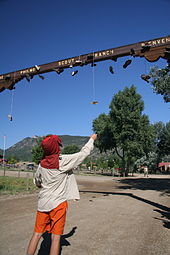 A Scout throws his boots over the Philmont entrance sign at Base Camp, a famous tradition. During the summer of 2009, the sign was hit by a bus and subsequently moved to a nearby location out of the entryway.
A Scout throws his boots over the Philmont entrance sign at Base Camp, a famous tradition. During the summer of 2009, the sign was hit by a bus and subsequently moved to a nearby location out of the entryway.
Its primary facilities are:
- The Welcome Center, a large pavilion, which serves as a waiting area for crews arriving or departing from the ranch, as well as crews leaving or returning on a trek. The Welcome Center's small office offers check-in instructions and general information.
- Camp Administration/Logistical Services, which manage registration and orchestrate all the ranch's operations.
- Two dining halls, one for campers and one for staff.
- Services, a large L-shaped building whose facilities include:
- Rental and return of gear and issuance of trail food
- Lockers, where crews may store anything they have brought but do not want to take on the trail
- A post office, which handles mail for staff and crew members
- The Health Lodge. Health officers communicate with backcountry staff by radio, and can dispatch Suburbans to retrieve patients if necessary.
- Tooth of Time Traders, which sells all manner of camping and backpacking gear as well as a large selection of souvenirs.
- The Snack Bar, in the same building at the trading post, which sells a variety of snack foods, beverages, and ice cream.
- Four chapels of four different faiths: Catholic, Protestant, Jewish, and Latter-day Saints. Each chapel holds services every evening, and most incoming and some outgoing crews attend these.
- Three tent cities: Trailbound, Homebound, and Staff. Each contains several showerhouses. The staff tent city's capacity is roughly 900, though it is rarely full; Trailbound and Homebound each hold between 400 and 500 trekkers.
Trail camps
A trail camp is a camp without a permanent staff presence. Trail camps always contain several campsites, but they can be spread out over half a mile of trail or more, so that there is no sense of crowding. Each trail camp is identified by a map, attached to a tree or the side of a latrine at every trail which passes through it.
Individual campsites are marked by:
- A wooden sign nailed to a tree which indicates the campsite number. Signs are not supposed to be touched by anyone, in order to preserve them.
- A metal fire ring. This may be used for small fires unless a fire ban is in place, which is often the case, given Philmont's dry climate.
- A sump. This is an L-shaped plastic pipe, with a two-foot vertical section and a ten-foot horizontal section perforated like a sieve. Most of it is underground, and the top is capped with a piece of mesh.[15] Sumps are used to dispose of dirty dishwater.
- Several campsites usually share a bear cable away from the campsite. This is a metal cable strung between two sturdy trees at least ten feet above the ground; it is used to hang bear bags containing items that might attract animals.
- Several campsites also share a latrine or toilet. Philmont latrines have the possibility of housing spiders below the seat, which is why campers are encouraged to remove possible pests on the underside of the boards with a stick. The latrines come in numerous configurations, but all of them are for excrement only, and are not to be urinated in, in order to reduce smell:
- The open-air style with two adjacent seats is affectionately called the "pilot to copilot" design; this results from the joking conversation which often takes place between two campers using the toilet simultaneously.
- The other open-air configuration, called the "pilot to bombardier", is generally preferred because its two seats are back-to-back and offer somewhat more privacy than the "pilot to copilot".
- Occasionally a "single pilot" - one open-air seat — may be found.
- The enclosed configuration, with walls and a red roof, is known as a Red Roof Inn. Older Red Roof Inns contain two adjacent seats and no door, while newer models have two back-to-back seats, with a wall between.
- "Time Machines" (also called port-a-pots) are very rare to find in the backcountry, only found in places such as French Henry.
Staffed camps
Many camps have several live-in staff members who are in charge of the camp's "program", which consists of a wide variety of activities. Camps often carry a historical or modern theme, such as logging (Crater Lake and Pueblano), mining or blacksmithing (French Henry, Cypher's Mine, and Black Mountain), fur trapping and mountain man life (Miranda, Clear Creek), challenge events (Dan Beard, Head of Dean, and Urraca) or western lore (Beaubien, Clark's Fork, or Ponil). The program in a camp is run by staff known as Program Counselors. These Program Counselors are supervised by a Camp Director.
Specific program activities include black powder rifle loading and shooting, shotgun shooting and reloading, .30-06 shooting, trail rides on horseback, burro packing and racing, rock climbing (on artificial towers as well as actual rock faces at Miner's Park, Cimarroncito and Dean Cow), tomahawk throwing, branding, search and rescue training, mountain bicycling, Mexican homesteading, blacksmithing, goldpanning, obstacle courses, archeological sites, spar pole climbing, and a variety of campfires and evening programs.
Most staffed camps contain several campsites of the same sort which appear in trail camps (with the exception of French Henry); however, the primary distinguishing factor is the presence of one or several cabins. There is always a main cabin, where an arriving crew is given a "porch talk" by one of the staff members. This includes information about available program, location of trash receptacles, and other timely information such as the presence of "problem bears." Camps in the Valle Vidal (Seally Canyon, Ring Place and Whitman Vega) have yurts, large circular semi-permanent tents which allow for bear defense but may be removed in the off-season in the interest of leave no trace camping, rather than cabins.
Most staffed camps have a swap box—a box in which crews may place unwanted food and take anything they might desire. Predictably, swap boxes tend to fill up with foods that people tend not to like, get too much of, or food no one wants to carry.
With several exceptions, staffed camps accept garbage (not trash), send and receive mail, and offer purified water. The exceptions are those camps which have no road access or where the camps receive their supply shipments by burro. All staffed camps also contain radios, by which staff members can communicate with Logistical Services, the Health Lodge, or each other. The radio is used for all manner of communication, including notifications of the movements of the ranch's various vehicles, logistical inquiries between camps and Base, major and minor medical issues, and a nightly itinerary read-out which often includes world news and a weather forecast. The ranch's non-stationary staff are assigned unit numbers, by which they identify themselves on the radio. The ranch also employs a variety of esoteric radio ten-codes for rapid communication.
In all, there are 34 staffed camps currently at Philmont Scout Ranch, by name: Abreu, Apache Springs, Baldy Town, Beaubien, Black Mountain, Carson Meadows, Cimarroncito, Clark's Fork, Clear Creek, Crater Lake, Crooked Creek, Cypher's Mine, Dan Beard, Dean Cow, Fish Camp, French Henry, Harlan, Head of Dean, Hunting Lodge, Indian Writings, Miner's Park, Miranda, Phillips Junction, Ponil, Pueblano, Rayado, Rich Cabins, Ring Place, Sawmill, Seally Canyon, Urraca, Ute Gulch, Whitman Vega, Zastrow.
Commissaries
A commissary is a small warehouse which is stocked by weekly truck shipments with trail food for campers, real food for backcountry staff, and various other supplies. Sometimes there is a small room in the warehouse that holds a trading post, which sells a small variety of odds and ends, including postcards, postage, and games, along with repair kits, white gas for crews' stoves, and other backpacking necessities. A crew typically stops by a commissary every 3–4 days in order to limit the quantity of consumables carried by the crew at any given point. Food is initially issued by the Services building in Base Camp, and is resupplied at the commissaries.
Philmont Museum and Seton Memorial Library
Philmont is also home to the Philmont Museum and Seton Memorial Library, which offers exhibits relating to the ranch's history and the history, art, and natural history of the Philmont area. The Ernest Thompson Seton Memorial Library is a research library containing Seton's personal collection and an extensive collection of volumes pertaining to western lore and the history of the area. Crews at the beginning or end of their trek can come here to sign up for a tour of the Villa Philmonte.
Kit Carson Museum
The Kit Carson Museum is a living museum that operates in the summer in Rayado, located 7 miles (11 km) south of Philmont's headquarters. Interpreters demonstrate 1850s period frontier skills and crafts including blacksmithing, cooking, shooting and farming. The museum also features exhibits about frontiersmen Kit Carson and Lucien Maxwell, who founded a colony at Rayado.
Notable former staff
- Wally Berg - Ranger in 1970s and Director of Conservation, first person to summit Lhotse in 1990.
- Steve Fossett - Ranger in 1961; also served on the Philmont Ranch Committee,[16][17] later a record-breaking aviator.
- Donald Rumsfeld - 1949 guide (forerunner to the Rangers),[18] later United States Secretary of Defense.
See also
- High-adventure bases of the Boy Scouts of America
- High adventure programs of the Order of the Arrow
- Roving Outdoor Conservation School
- Double H High Adventure Base
- James P. Fitch
- Florida National High Adventure Sea Base
- Northern Tier National High Adventure Bases
- Outdoor education
- Tooth of Time
- Wilderness Grace
- Girl Scout National Center West
- Mount Phillips (New Mexico)
Further reading
- William F. Cass, Return to the Summit of Scouting/a Scouter's Midlife Journey Back to Philmont, ISBN: 0923568298, Wilderness Adventure Books, 1993.
- William F. Cass, The Last Flight of Liberator 41-1133: The Lives, Times, Training & Loss of the Bomber Crew Which Crashed on Trail Peak at Philmont Scout Ranch, ISBN: 0970297203, Winds Aloft Press, 2000.
- Stephen Zimmer & Larry Walker, Philmont: A Brief History of the New Mexico Scout Ranch, ISBN: 0865342938, Sunstone Press, 2000.
- Michael Connelly, Riders in the Sky: The Ghosts and Legends of Philmont Scout Ranch, ISBN: 0936783303, Merril Press, 2001.
- Lawrence R. Murphy, Philmont: A History of New Mexico's Cimarron Country, ISBN: 0826302440, University of New Mexico Press, 1976.
References
- Specific
- ^ "2006 BSA Year in Review" (PDF). Boy Scouts of America. Archived from the original on February 27, 2008. http://web.archive.org/web/20080227033907/http://marketing.scouting.org/research/demog/02-030.pdf. Retrieved 2008-01-05.
- ^ Online guide to the continental Cretaceous-Tertiary boundary in the Raton basin, Colorado and New Mexico
- ^ "US Gazetteer files: 2010, 2000, and 1990". United States Census Bureau. 2011-02-12. http://www.census.gov/geo/www/gazetteer/gazette.html. Retrieved 2011-04-23.
- ^ a b c d Lawrence R. Murphy, University of New Mexico Press, Philmont, A history of New Mexico's Cimarron Country, ISBN # 0-8263-0438-9
- ^ Rock Rohrbacher, Philmanac, A Treckers Guide to the Philmont Backcountry, CSS Publishing, ISBN # 0-7880-1469-2
- ^ "Crash site dedication sign" PBase Photo Sharing, Troop 120 Carmel, Philmont photos 2006
- ^ "Last Flight of Liberator 41-1133" Amazon Books
- ^ "About Philmont". Philmont Scout Ranch. Boy Scouts of America. http://www.scouting.org/philmont/about/index.html. Retrieved 2006-08-31.[dead link]
- ^ [1]
- ^ In Memory: John Westfall - Douglas Fasching - philstaff.org - May 10, 2009
- ^ Organize Your Crew
- ^ "50-Miler Award" Boy Scouts of America website
- ^ Philmont Pride This Old Patch column Scouting magazine, November-December 2010 issue page 14
- ^ [2] Official Philmont web site
- ^ philmontscoutranch.org
- ^ "NESA President Steve Fossett: A Tribute" National Eagle Scout Association, Eagletter Winter 2008
- ^ High Country — Philmont Staff Association — October 2007
- ^ Secretary Rumsfeld's Remarks at the White House Conference on Cooperative Conservation - U.S. Department of Defense News Transcript - August 29, 2005
- General
External links
General
- Philmont Scout Camp - official site
- Museums at Philmont - Villa Philmont, Seton Memorial Library and Philmont Museum, Kit Carson Museum at Rayado
- Tooth of Time Traders, official website of the Philmont Trading Post
- Philmont Wiki, a wiki covering all things Philmont
- Philsearch: An interactive trek planner and virtual ranch tour
- The Philmont Forum - a message board and photo gallery for registered users to share information and experiences about Philmont and other Scouting high adventure.
- USGS Professional Paper 505, a geologic story of Philmont Scout Ranch made by the US Department of the Interior
- The Philmont Explorer A searchable database of Philmont trek itineraries and other information
- Voices of Oklahoma interview with Elliot "Chope" and Virginia Phillips. First person interview conducted on May 5, 2009 with Elliot "Chope" and Virginia Phillips, son and daughter-in-law of Waite Phillips. Original audio and transcript archived with Voices of Oklahoma oral history project.
- http://www.philmontmovie.com/ The most comprehensive set of documentaries made about Philmont on DVD and Blu-ray. Hi lights the history and development of the Philmont and show the impact by following a crew through the peaks and valleys of their trek.
Applications
- Rayado application and additional information
- ROCS application and additional information
- Trail Crew Trek application and additional information
Staff
- Philmont Staff Association website
- Philmont Staff, an archive of messages from mainly former staff members
- Tobasco Donkeys musical group
Other
- Philmont links collected by Selden Ball
- Google Map of Philmont with points of interest marked.
 Scouting and Guiding topics
Scouting and Guiding topics 
The Scouting Movement Sections Founders, pioneers, and notable leaders Prominent places International Scouting - Confédération Européenne de Scoutisme
- International Scout and Guide Fellowship
- Order of World Scouts
- Scouts-in-Exile
- International Union of Guides and Scouts of Europe
- World Association of Girl Guides and Girl Scouts
- World Federation of Independent Scouts
- World Organization of the Scout Movement
Other Categories:- Buildings and structures in Colfax County, New Mexico
- National camps of the Boy Scouts of America
- Philmont Scout Ranch
- Boy Scouts of America
-
Wikimedia Foundation. 2010.

